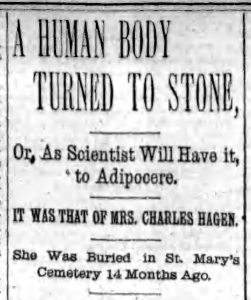 Albany has a history of digging up bodies and moving them around (as any old city does). Sometimes, that resulted in some surprises. In 1893, a transfer from one cemetery to another resulted in finding “A Human Body Turned to Stone,” although stone isn’t quite as good as another description. Albany had a Soap Lady.
Albany has a history of digging up bodies and moving them around (as any old city does). Sometimes, that resulted in some surprises. In 1893, a transfer from one cemetery to another resulted in finding “A Human Body Turned to Stone,” although stone isn’t quite as good as another description. Albany had a Soap Lady.
“Cases of putrefaction of human bodies are so rare that when one is accidentally brought to light it becomes a matter of curiosity and interest. Such a case has just been discovered in this city.”
Mrs. Charles Hagen (nee Miss Crinnen, no first name given) had been a resident of Albany but died in Newark, New Jersey in February 1892. Her body was brought to Albany for burial in St. Mary’s cemetery, then far out Washington Avenue, roughly where the high school and Army Reserve Center are today. According to the Albany Morning Express (May 12, 1893), “Of late many bodies buried in St. Mary’s cemetery have been taken up by relatives and reburied in St. Agnes’ cemetery. Among those was that of Mrs. Hagen, whose family is well known in this city.” Also buried in the plot was her husband’s father, buried in 1864 or 1865. In digging them out,
“On reaching the top of the rough box they were surprised at finding it in a far better state of preservation than they could have expected after it had been buried more than a year. The box, which to the workmen appeared unusually heavy, was hoisted from the grave. The rough box was not in the least decayed, and looked no worse than it might if it had been merely exposed to the rain and sun for a week or two. The relatives were notified of the peculiar fact of the preservation of the box, and they became anxious to see the body. They consulted with Superintendent Gibbons, of St. Mary’s cemetery, and had the covers of the rough box and casket unscrewed. What they saw surprised them not a little. There had been scarcely any change in the appearance of the body. The f ace looked almost as it did when the casket was first consigned to earth. An examination of the body revealed the reason for its remarkable preservation. It was as hard as stone to the touch; in fact it was what is commonly called “petrified,” although it is claimed that the process of true petrifaction never takes place in human bodies, but that the tissues are transformed into a substance that is called adipocere, which is about the consistency of hardened putty.”
This is a thing. A rare thing, but a thing nevertheless. The Mütter Museum in Philadelphia prominently features “The Soap Lady,” a woman whose body was exhumed in Philadelphia in 1875; a fatty substance, adipocere, encases her remains. “Adipocere formation is not common, but it may form in alkaline, warm, airless environments, such as the one in which the Soap Lady was buried.” The Soap Lady is now believed to have died in her late 20s; Mrs. Hagen was only 24 when she died. Her body, along with her father-in-law’s, were reburied in St. Agnes Cemetery. “A number of persons who had heard of the case gathered at St. Agnes’ cemetery on Sunday in hope of seeing the body, but were disappointed.”
According to the Troy Irish Genealogy Society webpage on St. Mary’s, disinterments from St. Mary’s began around 1875 and weren’t complete until 1917. After that, the land was known as St. Mary’s Park, used as a temporary housing site following World War II, and eventually became the site of Albany High School.
Unfortunately, we can’t reconcile Mrs. Hagen’s birth and death dates with any of the currently recorded reinterments from St. Mary’s or the current interments at St. Agnes, so the particulars of her life, including her first name, escape us.
